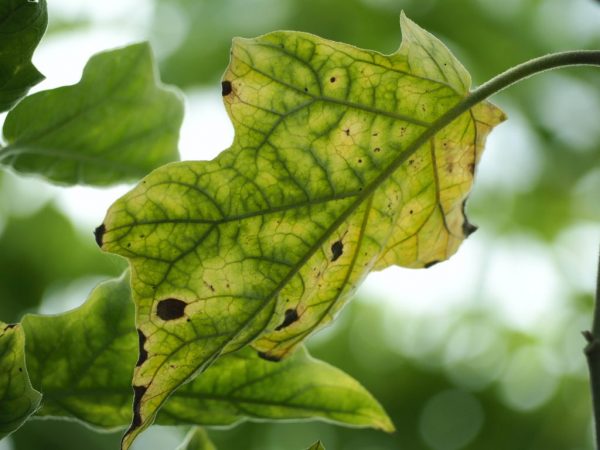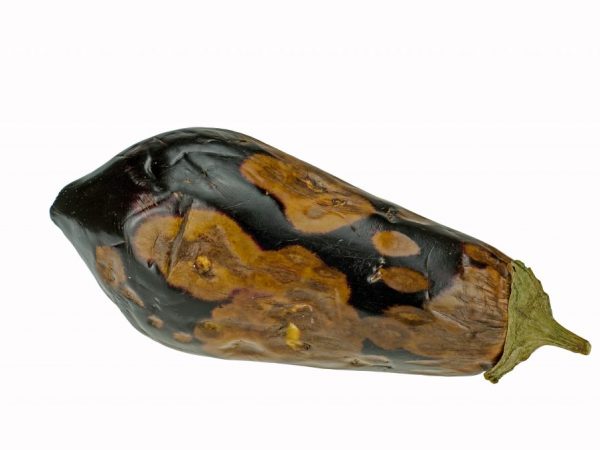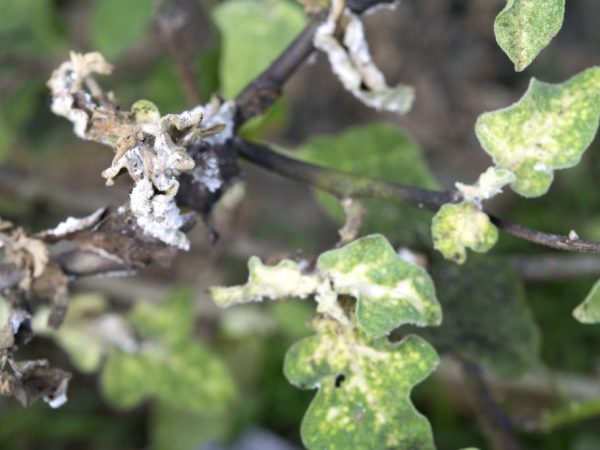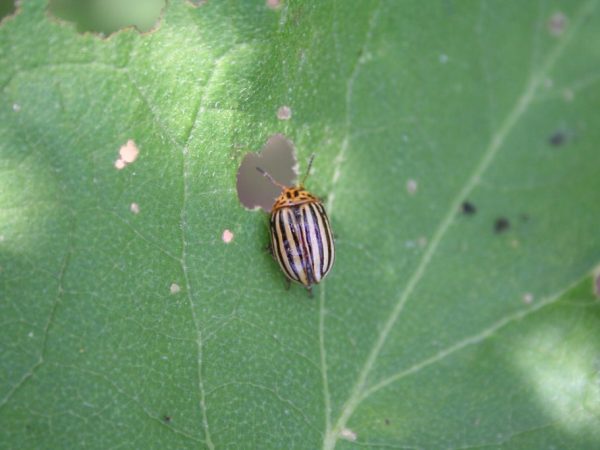Existing eggplant diseases and their treatment
Eggplant is susceptible to a variety of diseases and parasites. Therefore, in the process of growing them, many gardeners have difficulties. In the article, we will consider the existing diseases of eggplant and their treatment.

Existing eggplant diseases and their treatment
Classification
Diseases and pests affect eggplants at all stages of growth and development. The most common diseases are divided into several groups, depending on what pathogen they are caused by:
- viral;
- fungal;
- bacterial.
Viral
Tobacco mosaic
This viral disease of the leaves of eggplant is characterized by the defeat of all parts of the plant, and at all stages of growth.
Signs: leaves, stems of seedlings are covered with yellow spots. In case of significant damage, the plants are removed from the greenhouse.
The planting site of seedlings is treated with a solution of quicklime. This disease cannot be treated.
Pillar
This is an incurable disease of the blue, which affects both in greenhouse conditions and in the open field. It is not difficult to notice this sore on eggplants - the stems of the plant become thicker than usual, they break easily. If the leaves turn purple-red, with a corrugated surface, this is also a sign of a pillar.
To protect the planting, it is worth regularly removing weeds, conducting pre-planting seed preparation by disinfection. Treatment with Actellik is also carried out.
Gray rot
At the initial stage of development, it is difficult to notice this sore. Signs are visible in the last stage of the lesion, when leaves and shoots are covered with gray or white bloom. In appearance, it resembles mold.
You can get rid of gray rot with the help of systemic fungicides. To prevent the development of the disease in subsequent years, the soil in the greenhouse or seedling box is decontaminated by fumigation.
In the process of development of gray rot in adult plants, the fruits dry out and become covered with a gray bloom. They can no longer be eaten.
Fungal
Blackleg
This eggplant disease is common. You can identify the black leg by the black girdle on the stem of the plant. Such a bridge completely blocks the plant's access to nutrients and moisture. This leads to a poor quality and poor harvest of vegetables.
It is worth treating the black leg with Trichodermin. If such a struggle is useless, the ailing sprouts are removed from the greenhouse, because they are carriers of a fungal infection - the causative agent of the black leg.
Phytophthora
Eggplant late blight is a dangerous viral disease that manifests itself on the leaves in the form of rusty spots.
To preserve seedlings, remove all viral-infected plantings to stop the spread of the disease to healthy plants.
Treatment of late blight eggplant is carried out by spraying the plantings with Bordeaux mixture or copper sulfate.
Late blight affects not only young, but also adult plants, as well as fruits.
Sclerotinosis

Disease can ruin crops
The people call this sore white rot. Its pathogen settles in the root system of seedlings, multiplies and moves to the stem. Access to food is closed over time. The stem becomes watery, and the leaves and fruits are covered with wet and dark specks.
In adult plants, black seals form on the fruits - sclerotia. The reason for the development is that the plants froze when planted in cold and waterlogged soil.
To prevent the onset of the disease, it is worthwhile to carry out the procedure for disinfecting the soil before planting seeds, and also to lower the humidity in the greenhouse. Diseased plants should be sprayed with Bordeaux liquid or copper sulfate.
Fusarium
Fusarium wilting appears on plants growing in a greenhouse. The fungal infection penetrates the stems, the leaves become lethargic, necrosis appears on them.
Reasons: high air humidity and high temperature (23-26 °).
Due to the high resistance of the pathogen to fungicides, Fusarium cannot be treated. To prevent the emergence of infection, you need to disinfect the planting soil and seeds.
Cercosporosis
Chlorosis or cercosporosis is another dangerous fungal disease.
Signs of cercosporosis: round chlorotic spots on foliage. After a while, they increase in size, affecting the entire leaf plate. The leaves die off, while the plant does not die, but bears fruit with unsuitable fruits.
Protection against damage consists in observing the rules of crop rotation, disposal of plant waste and control of air humidity in the greenhouse.
The fight against this disease of eggplant seedlings is carried out with the help of Bordeaux liquid. Treatment with one of the traditional fungicides is also possible. Additionally, plants are fertilized with complex preparations to increase resistance to chlorosis.
Anthracnose
This disease rarely affects greenhouse seedlings. Seedlings growing in open ground are more often infected. This eggplant disease manifests itself on foliage as red oval spots.
Prevention involves compliance with the rules of crop rotation, as well as timely cleaning of the site from weeds and plant residues.
The drug Hom will help with this eggplant disease - 0.3% concentration.
Dry rot
Eggplant rot is caused by a fungus. The reasons are humid air and high temperatures. Young shoots are subject to defeat, which first turn green, then turn brown and dry out.
Eggplants also rot in adulthood, as well as at the stage of fruiting. The surface of the plant is covered with brown spot.
Diseased plants should be treated with fungicidal preparations - Mancozeb, Carbendazil or Chlorotonil. You can also process seedlings with Bordeaux mixture.
Black spot
Green shoots are sick with black spot due to an excess of moisture in the soil, increased soil density and thickening of the plantings.
How to save young plants:
- loosen the soil periodically;
- make drainage holes;
- thin out too densely spaced seedlings.
Treatment of this eggplant disease is carried out with systemic fungicide preparations. The humidity in the room also decreases.
Powdery mildew (false and real)

Processing will help save plants
This disease of eggplant seedlings is characterized by massive leaf drying. The result is wilting and death of plants.
The main causes of damage are sudden temperature changes and high air humidity.
Treatment of false eggplant disease in a greenhouse involves processing with a chemical agent - Fitostorin. It is necessary to reduce the dose and frequency of watering for the plants and regularly ventilate the greenhouse.Avoid drafts while airing, otherwise the seedlings will die.
For the treatment of powdery mildew, Topaz and colloidal sulfur are used.
Top rot
The appearance of eggplant apical rot occurs due to a lack of potash fertilizers. The disease is not contagious and can be easily eliminated by feeding with preparations containing potassium.
Top rot manifests itself at all stages of plant growth, including during the fruiting period. Monitor the frequency and regularity of potash dressings.
Bacterial
Fungal diseases of eggplant seedlings and the fight against them has an equally important role, because they lead to serious damage to the landings and their death.
Bacterial spot
This disease affects plants at any stage of development, both in greenhouse conditions and in the open field. Black spots appear on the leaves, the border becomes yellow. Petioles and stems also turn black over time.
Bacterial spotting develops at high temperatures and high humidity.
Infected plantings are removed from the site. For prevention purposes, disinfect seeds and soil before planting. Such a sore cannot be treated.
Pests
The most common pests of eggplant seedlings are aphids, spider mites and slugs.
Aphid
You can fight aphids with both folk remedies and modern pesticides:
- treat seedlings with Karbofos or Arrow;
- aphids are destroyed with a solution of wood ash (200 g of substance are consumed per 10 liters of water);
- some gardeners use iodine to fight aphids - 10 drops of the substance are added to 1 liter of water.
Slugs
Loosening the soil in hot weather and its subsequent pollination with mustard powder, ground black or red pepper will help to destroy slugs.
Whitefly and Colorado potato beetle

Get rid of insects
Whitefly and Colorado potato beetle are eggplant pests, no less dangerous for seedlings. Treatment with Iskra-bio or Fitoverm helps to get rid of the whitefly. Colorado beetles and their larvae will have to be harvested by hand.
Midges
If a fly appears on the seedlings, it is urgent to get rid of it. Such a small insect, although not harmful to plants, will become a carrier of many diseases.
To drive out the fly, gardeners use various folk remedies - they spread citrus bark, tobacco, garlic on the soil, set special traps and spray the seedlings with soapy water.
Medvedka
Often, the root system of plants is affected by this particular pest. If a bear appears in the garden, you can get rid of it by the following methods:
- For 10 liters of water, 30 g of Chlorophos. The working solution is poured into the pest's burrows.
- Dig a shallow hole on the site, sprinkle with manure. At the end of spring, the bear will crawl into it to lay eggs. The manure with the larvae is collected and burned.
- Eggshells collected during the year are crushed into small pieces and poured into the pits of the parasite.
Illiterate care
Withering, yellowing and drying of seedlings are caused not only by plant diseases, but also by improper care:
- At high air humidity, plants become watery, begin to wilt and turn yellow. To eliminate this problem, arrange for regular ventilation.
- From a lack of nutrients in the soil, seedlings may turn yellow and dry out at the initial stage of growth. Provide your plants with a balanced diet of phosphate and potassium fertilizers.
- With a lack of moisture and good lighting, the sprouts develop for a long time and soon dry out. Do not keep seedlings under the sun, young eggplant seedlings can get burned and die.
- With excessive watering, the roots rot and root rot develops. Therefore, it is worth watering as the soil dries up.
- Hypothermia is another reason why the seedlings begin to hurt, wither and die. Avoid drafts and sudden temperature changes during hardening.
When growing seedlings, follow the rules of planting and care: disinfect the seeds, use sterile, fertile and light soil for planting.
Conclusion
Despite such a huge number of diseases and pests, eggplants can still be protected from their defeat. To grow successfully, follow preventive measures and optimize care for your plantings.


